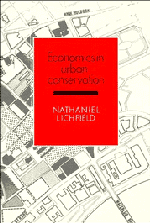Book contents
- Frontmatter
- Contents
- List of diagrams, tables and plans
- Preface
- Acknowledgements
- Introduction
- Part I Planning and management in the conservation of the urban system
- Part II Conservation of the cultural built heritage
- 4 The nature of the cultural built heritage
- 5 Identification and protection of the CBH
- 6 Management and planning in the conservation of the urban cultural heritage
- Part III Economics in urban conservation
- Part IV Selected tools of economic analysis for project evaluation
- Part V Case studies in the economics of conservation of the CBH
- Notes
- Bibliography
- Index
4 - The nature of the cultural built heritage
Published online by Cambridge University Press: 10 November 2010
- Frontmatter
- Contents
- List of diagrams, tables and plans
- Preface
- Acknowledgements
- Introduction
- Part I Planning and management in the conservation of the urban system
- Part II Conservation of the cultural built heritage
- 4 The nature of the cultural built heritage
- 5 Identification and protection of the CBH
- 6 Management and planning in the conservation of the urban cultural heritage
- Part III Economics in urban conservation
- Part IV Selected tools of economic analysis for project evaluation
- Part V Case studies in the economics of conservation of the CBH
- Notes
- Bibliography
- Index
Summary
Man's heritage
At any moment in time, any society is using its general heritage from the past, namely all that it inherits from its forebears. This is very varied in character. It can be categorised in relation to our concept of the urban and regional system (1.2) as follows:
Physical stock
(a) natural resources: land, with its minerals, agricultural and timber products, animal and bird life; the water, with its fish and plant life; the environment in sun, air, rain, climate;
(b) man-made: works and buildings which are attached to the land (immobile);
(c) man-made: works which are not attached to walls and buildings (mobile).
Activities
(a) consumption: quantity and kind of goods and services available to people for their standard and quality of life;
(b) production: way in which society has learned to provide the goods and services for consumption;
(c) religion: relation with the God(s) of the country and the institutions which serve that relation;
(d) arts: graphic, music, dance, literature, film, plays;
(e) knowledge: accumulated and transmissible through education and training of all kinds;
(f) folklore: collective memory of past generations, absorbed through the family, teachers, etc.;
(g) tradition: carrying out activities in a manner reminiscent of previous generations.
By definition, this heritage is continually growing, both with the rise in numbers of population who are able to transmit to the future, and the increasing amount of heritage goods and services of the above categories which are left behind. But the rate of growth is not uniform in all categories.
- Type
- Chapter
- Information
- Economics in Urban Conservation , pp. 63 - 76Publisher: Cambridge University PressPrint publication year: 1989



